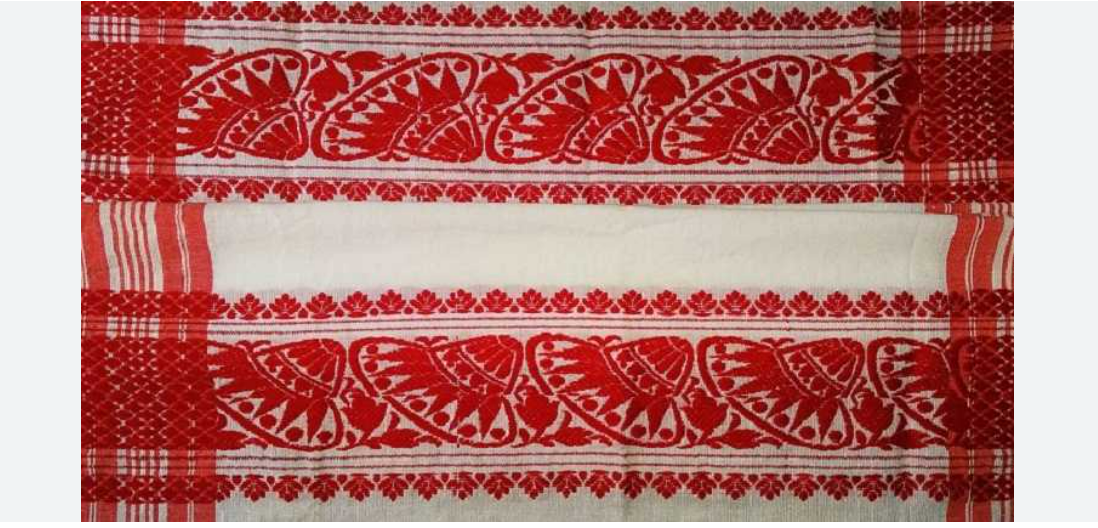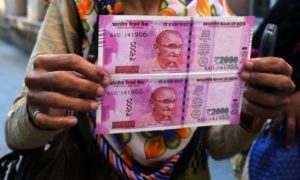The ‘gamosa’ is worn as protective headgear while working in paddy fields, offered to elders as a mark of respect, and a must-have during ceremonial occasions such as religious events and weddings.
The gamosa or gamusa, a traditional towel used in Assam, gained international recognition when Prime Minister Narendra Modi wore it while receiving the first dose of the Covid vaccine. The handwoven red-and-white towel, which is intrinsic to the state’s larger sociocultural fabric and ubiquitous in every household, has now been officially awarded the geographical identification (GI) tag.
Traditionally white in colour with a woven red thread design (preferably on cotton), this hand towel was also used as political ammunition when the Congress began a drive to collect 50 lakh “anti-CAA” gamosas during the campaign for the Assam assembly elections. The intention was to display the towels at a proposed memorial for those killed during the anti-CAA movement.
The gamosa has received the GI tag four years after the Patent Information Centre (PIC) of the Assam Science Technology & Environment Council (ASTEC) applied for it. While the tag is a recognition transcending beyond politics, shipping minister Sarbananda Sonowal lost no time in announcing the achievement calling it “Assam’s pride, shining bright”.
Assam's Pride, Shining Bright!
— Sarbananda Sonowal (@sarbanandsonwal) December 13, 2022
Due recognition of our heritage & cultural identity. Gamosa gets the GI tag, bringing joy to thousands of weavers of this special item that has become a global symbol of Assam.
Congratulations to all. pic.twitter.com/6abQTsc4Rp
“Muga silk was the first to get a GI tag in Assam and the entire northeast. The Orthodox tea was the second and the gamosa is now the third, and this is a result of hard work. Initially, it was the Assam Agriculture University at Jorhat that applied for the GI registration but we at ASTEC and its PIC worked on it in an exhaustive manner and applied for the GI registration in 2018, a year after the university’s application. The GI tag recognises weavers and their effort. It also paves the way for gamcha in Bihar or other states to apply for their geographical identification,” said Dr Ranjit Kumar Burman, former head of department, science and technology, ASTEC.
Assam chief minister Himanta Biswa Sarma said: “A day of pride for Assam, as our gamosa gets a geographical indication tag by the Government of India.” He expressed his gratitude to Prime Minister Modi, who is often seen with a gamosa draped around his neck. Sarma congratulated all the people of Assam for this recognition.
“The news literally gave me goosebumps. The gamosa is our pride and identity. I would now like to request the government of Assam to ensure that youths of Assam, who are employed, can be provided looms to weave these gamosa so its illegal trade and manufacturing out of the state can be checked,” said Hemoprova Chutia, a weaver and recipient of the Assam Gaurav award.
Here is all you need to know about Assam’s iconic textile:
THE GENESIS OF THE GAMOSA
The gamosa is worn as a protective headgear while working in paddy fields or in the kitchen garden. During the Bihu festival, youngsters offer gamosa to their elders as a mark of respect and love. The altars of the temple and satras are decorated with gamosa bearing floral motifs along with the words ‘Krishna’, ‘Ram’, ‘Hari’. When Assamese people visit temples or any religious place, carrying a gamosa around the neck and shoulders is a must. It is considered to be one of the three vastras of bhakts and Vaishnavas without which they are not entitled to enter a namghar or satra.
The textile unites the Assamese and is a symbol of belongingness — a mark of welcome, respect for elders, and love for dear ones.
THE MANY TYPES OF GAMOSA
Based on available documents and research, the gamosa are broadly classified as follows:
Uka/xadharon gamosa or Uka gamosa
Generally for daily purposes, uka means plain. Hence, this type of gamosa has two red borders on both sides and does not have any design on its aanchal (ends). The length and width of uka gamosa is 150 cm x 70 cm and the type of yarn used is kechasuta of count 26s, 30s, 40s. It has more absorbency as compared to other variants, and so is frequently used to wipe the face and body after a bath and also during ritualistic occasions like puja. It is also known as xadharon gamosa, which means it is for daily use for wiping face and body, during cultivation as headgear. Shepherds use this variant during their work and it is also by the fishing community.
Phulam gamosa/Phulam
This gamosa is the most adorned piece made by Assamese weavers. It can be considered as regional clothing. The phulam gamosa is 150 cm long and 70 cm wide. It is considered a special variant and showcases a weaver’s craft. A yarn count of 2/80 is normally used to produce the phulam, which is of a fine texture. The red colour in this gamosa is a symbol of confidence and strength. Further, most of the flowers of the spring season are red, which is another reason it is used in phulam gamosa. Other than floral motifs, traditional Assamese jewellery designs, bird and animal motifs, dancing girls and boys, snapshots of the fishing community are included in the phulam gamosa. It is offered to show respect to elders, guests, eminent and well-known personalities during gatherings, as well as a symbol of love and affection to near and dear ones and priests.
Bihuwan
Bihuwan is a type of gamosa closely associated with the festival of Bihu, which is celebrated at the onset of the Assamese new year at the beginning of the month of bohag (mid-April). It derives its name from the festival and is gifted to family members on Bihu. In rural areas, there is an unannounced competition among young girls on designing the best Bihuwan gamosa for her partner or lover. Even mothers-in-law present the attractive Bihuwan to their sons-in-law on Bihu. Its position is high in society and its name derives its importance from its association with ‘Bohag Bihu’, also known as ‘Rongali Bihu’, which is the main regional festival of Assam.
Tioni/Pani gamosa
The size of the tioni is 200 cm x 100 cm of plain weave. It is most widely used by the people of lower Assam. It is a knee-length gamosa worn for work in paddy fields or in the kitchen garden. There is generally no design on this gamosa. The yarn used is pure cotton, so that it easily absorbs water and can be washed more frequently. Senior citizens in rural areas use this more commonly, and it is also known as pani gamosa. The use of this name started during the Ahom reign and only the royal family could wear the dress below the knee. The general public wears it above the knee. Pani gamosa is also known as adho vastra, as it reaches below the knee. After the Ahom kingdom ended, the public started wearing this gamosa in their day-to-day lives.
Anakata gamosa
The anakata gamosa is 150 cm to 200 cm long and 75 cm wide. Its significance is that only a single piece is woven at one time. It is separated from the loom without cutting the warp yarns. The bride and groom use the anakata gamosa throughout the day at their wedding while performing rituals. The Assamese believe that the use of anakata gamosa protects the couple from the evil eye.
Telos gamosa
The telos gamosa is 200 cm x 117-122 cm. During a wedding, there is a ritual of bathing in a traditional manner, where the bride and groom are washed with holy water after using the paste of black gram and turmeric along with mustard oil. After this ritual bath, the telos gamosa is used to wipe their bodies and when the wedding ceremony is over and the new bride enters her in-laws’ house, the groom has to wear a telos gamosa for a few days as part of the rituals.
Dora boron/Jor gamosa
The size of this gamosa is 175 cm x 70 cm. Dora means bridegroom and its significance is that the garments sent from the bride’s home are accompanied by dora boron or jor gamosa. The fabric used is silk and, sometimes, it is decorated with gold thread. Both the edges of this gamosa are finished with a special dahi known as keresi. This decoration increases the beauty of gamosa. A special yarn is traditionally used in keresi. Floral designs are used on both sides across the border. The Assamese believe that Hindu deity had both the characteristics of a man and a woman — right side is for man and left for woman — and this is why floral designs are used on both sides across the border. It means a boy is merging in the life of a girl.
Gosain gamosa
This gamosa is generally 140 cm x 68 cm but can also be made in other sizes as needed. It is woven on a dedicated loom or as a first piece in a traditional loom, only to be used for religious activities. It is used to cover religious books while motifs of religious significance are present throughout its body. Words like Ram, Hari, Krishna are woven on it in Assamese language.
THE GAMOSA’S HISTORY
The origin of the word gamosa comes from the Sanskrit word gatro marjoni, which refers to a fabric used to absorb water or to wipe the body after taking a bath or to keep betel nuts, or used as headgear. According to Dr Birinchi Kumar Baruah, gamosa is known as angvastra and came from the word angochha, which means gamosa.
The size and functions of the textile are different and its approximate length varies from 1.30 m to 1.85 m while width varies from 60 cm to 85 cm. The length-wise border and cross-wise border with design is usually red in colour, which is known as anchu. Originally, the red colour was derived from the plant ‘anchu’, the scientific name for which is Morinda angustifolia. The lengthwise border or pari has three red strips known as sotia and, in between these, there are pooli. This is the actual arrangement of pari. Some selected floral motifs in crosswise borders are used between two typical kasori designs (creeper with floral motif). The portion between designs of two crosswise borders are known as khioni. Other than red, green, coffee, brick are also used for different purposes. Specifically, red is related to blood and is the symbol of confidence and bravery. The unwoven lengthwise yarn in both ends is known as dahi.
GAMOSA IN ASSAMESE SOCIETY
The gamosa is part and parcel of Assamese culture, and used in all ceremonies, events and functions. It has significance from ancient times as it was known to be widely used at the time of Sri Sri Manta Sankardeva, Sri Sri Madhabdev and Ramananda who used gamosa as headgear when they visited Sankardev’s wife to inform her of his sad demise.
The Assamese people are also known to have used gamosa with red anchu on both the ends, as headgear during the reign of Ahom king Syo-Ka-Pha. It is not properly known which community first started using gamosa in Assam, but the annals of history reflect that alpines might have first started gamosa in Assam.





































